"Patent Pages" -- The Corkscrews
by Ray Klingensmith
Reprinted from "INSULATORS - Crown Jewels of the Wire", May 1979, page 23
On May 1, 1883,
Joseph S. Lewis of England was granted a U.S. patent for an insulator with a
screw threaded exterior for the purpose of eliminating the need of a tie wire.
(See patent copy.) instead of the usual tie wire being used, a horseshoe shaped
clip could be attached to the line wire and placed at the top of the insulator.
The insulator was then turned in a direction so that the "screw
threads" of the exterior would force the clip downward. The screw threaded
top became larger as it went down, putting pressure on the clip until it was
tight against the insulator. After the insulator and wire was attached, it was
then mounted to a pin or bracket. Keep in mind that this was an English design,
and it appears the pin was probably an unthreaded version which was cemented to
the insulator. Notice that Frank L. Pope was the attorney who took care of the
patent for Lewis in the U.S.
On December 25, 1883, the same Frank L. Pope had a
different version of the Lewis insulator patented. This brings forth some
interesting questions. Did Lewis have any connection with the second patent? Did
Pope revise the insulator and patent it to make a profit of his own? It appears
Pope could have had some personal profits in mind; but one must take into
consideration what an activity like that could do for one's reputation. An
attorney who was known to do that might in the future lose a lot of patent
business. The people patenting items might fear their inventions would be stolen
by their attorney! So it's hard to say without further research.
The Pope patent
was much the same on the exterior. The new idea was to have an internal screw
thread also. In the Lewis invention the insulator was attached to the pin after
being fastened to the line wire. In the Pope invention the interior screw
threads were in the opposite direction as those on the top exterior, which
allowed both the application of the line wire to the insulator, and the
insulator to the threaded pin, in the same motion. It's interesting that the
drawing in the Pope patent shows a "corkscrew" with an inner skirt. In
the patent application, Pope states: "An annular groove, e, (see patent
drawing, ed) is preferably formed in the lower portion of the insulator for the
purpose of preventing the moisture which may fall upon the surface of the
insulator from reaching the support, thereby impairing the insulation." The
"inner skirt" was used by Samuel Oakman in his manufacture of
insulators for many years before this, and, luckily for him, he finally got
around to applying for a patent on this invention, which was granted just one
month before Pope's patent. Both patents had been pending for several months.
The actual insulators produced under this patent were made by The National
Insulator Company, a firm which was in existence in the mid 1880's in Boston,
Massachusetts. Exact dates of insulator production are unknown to me. There are
many variations found in the "corkscrews". The smaller version, which
has been assigned CD# 110.5, has two base embossing variations (see page
following). Figure one shows the embossing with the word "INSULATOR"
spelled out completely. Figure two shows the word abbreviated "INSUL.".
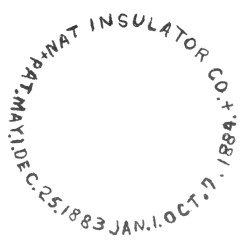 |
 |
|
Fig. 1 Embossing found on the base of the CD
110.5. |
Fig. 2 National embossing with "INSUL." abbreviation. |
A small amount of the corkscrews were
made specially for the New England Telephone & Telegraph Company. There are
two embossing variations of these. One is arc embossed on the skirt. Another has
the embossing straight across the skirt (see fig. 3 & 4).
 |
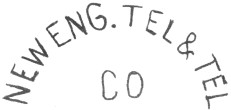 |
|
Fig. 3
"Straight across" NE T&T embossing found on the skirt of the CD
110.5. This may be the earlier variant. |
Fig. 4 The "arc" embossing
which may have been a later trademark of NE T&T. |
It's my opinion that the
"straight across" embossing was made before the arc embossing. Perhaps
NE T&T decided to adopt the arc embossing as their trademark, and after
ordering the straight across embossing, later ordered the arc embossed ones. I'm
not sure if all the arc embossed ones have the following characteristic, but the
one in my collection has a slug plated area in the same location where the other
style embossing would have been, on the opposite side of the mold (see fig. 5).
I just noticed this a short while ago, so please advise me if you have seen or
own an arc embossed one with or without the slug plate area, so it can be
determined how many were made that way. I also saw a CD 104 with the arc
embossed New Eng Tel & Tel Co and Nat. Ins. Co. base embossing that had a
very similar slug plated area as the CD 110.5. Could these have been some CD
104's made with a straight across embossed NE T&T?
The CD 110.5 also has two
types of threads. One is a two segment thread, made under a Lawrence B. Gray
patent, dated October 7, 1884. The other type is a fully threaded interior. The
fully threaded interior has two sets of parallel lines going from the lower
section of the threads, upward to the top of the pinhole.
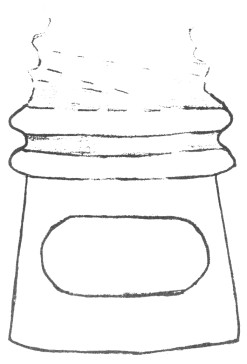 |
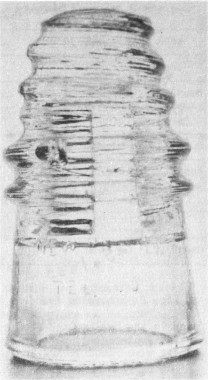 |
|
Fig. 5 Back
side of the arc embossed NE T&T showing the "slug plated" area, which may have removed the "straight across" embossing. |
Front view of a CD 110.5
showing the NE T&T embossing and two-segment threads. |
These lines are the creases caused from the type of collapsible plunger used in
the manufacture of these insulators. The collapsible fully threaded plunger was
another Lawrence B. Gray patent issued on October 7, 1884.
There is another
larger style of this insulator which has been assigned CD# 110.6. This style is
much rarer than the CD 110.5. These units were also made by the National
Insulator Company.
The small corkscrews were used in a widespread area. Most of
them that I've heard of came from the east-central part of New Jersey. They were
used on a railroad line. If I'm not mistaken, it was on the Pennsylvania
Railroad. They were also used in various New England states, and I have heard of
at least one having been used on a telephone line in southeastern New York
State. It may be as much of a surprise to all the readers as it was to me, when
I learned they were also found in northeastern Ohio. In fact, I recently
purchased one that was dug in a dump eight years ago not too far from where I
live. In fact, not more than four hours ago, the person who originally found it,
took me to the dump where it was found! It was rather fun digging. This other
person came up with two broken cork-screws today, and the pieces are resting
comfortable on my table as I write this! Only one whole insulator was found
today, a CD 120, 1871 patent. But we had fun!!!
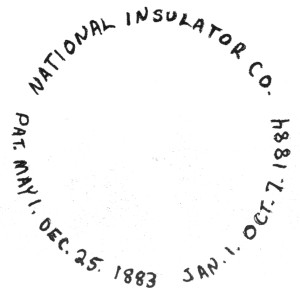
Fig. 6 Embossing found on the CD 110.6. |
Now back to the article. The arc
embossed NE T&T's are said to have been used in various locations of New
England, but strangely enough were also used in the south-central provinces of
Canada, which seems strange to me. The "straight across" NE T&T is
used in the New England area also. At least one CD 110.6 was found in the
east-central part of New Jersey. Tom Moulton reports that others were found in
New England on a fire alarm system.
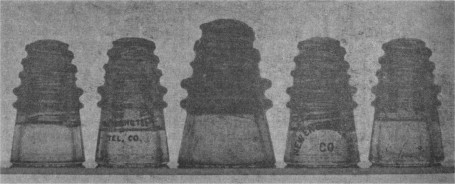
Tom Moulton Photo
From left to right: fully
threaded CD 110.5, "straight across" embossed NE T&T, CD 110.6,
arc embossed NE T&T, segment threaded CD 110.5. |
On the following page is a
chart showing the color, style, and embossing variations.
Thanks to Tom Moulton, Mike Johnson, and John O'Dell for their
help with this article. It's you, the readers, who supply the information to
make the columns more interesting each month. Let me hear from you.
| Item # |
CD # |
Base embossing (Fig. 1, 2, 6) |
Skirt embossing (Fig. 3 &
4) |
Type of threads |
Color |
| 1 |
110.5 |
1 |
-- |
REG |
Aqua |
| 2 |
110.5 |
2 |
-- |
SEG |
Aqua |
| 3 |
110.5 |
2 |
-- |
SEG |
Lt. Green |
| 4 |
110.5 |
(?) |
Fig. 3 |
REG |
Aqua |
| 5 |
110.5 |
2 |
Fig. 3 |
SEG |
Aqua |
| 6 |
110.5 |
2 |
Fig. 3 |
SEG |
Lt. Green |
| 7 |
110.5 |
1 |
Fig. 4* |
REG |
Aqua |
| 8 |
110.6 |
6 |
-- |
REG |
Aqua |
| 9 |
110.6 |
(?) |
-- |
REG |
Lt. Green |
* Note: Front
side of the skirt has the arc embossing, back side has the slug plate (fig. 5).
Please advise me if this comes without the slug plate.
|
